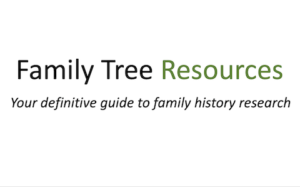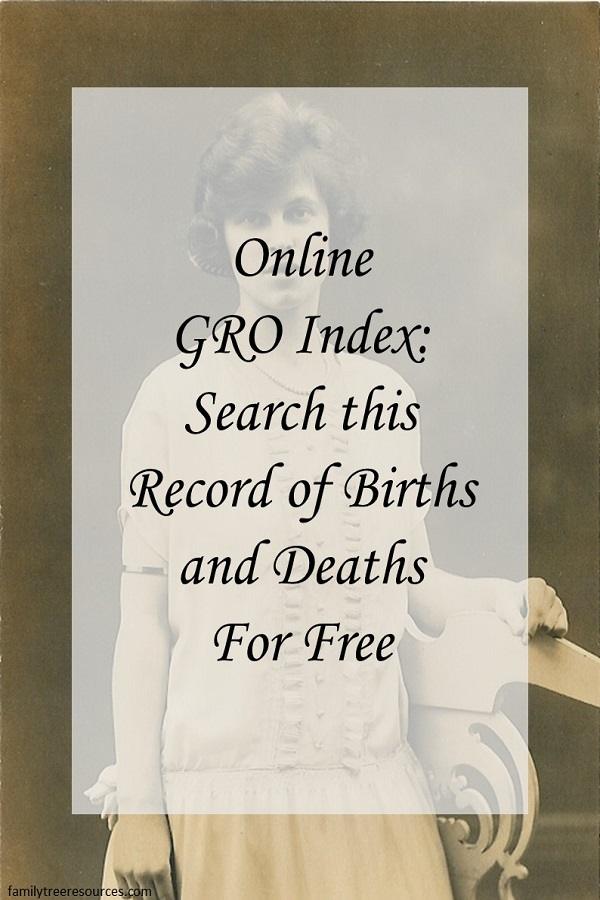
The GRO Index is a national schedule of births, marriages, and deaths that began on 1st July 1837 when Civil Registration came into force.
The country was partitioned into civil registration districts, each of these districts then being divided into sub-districts.
A local registrar assumed responsibility for each of these sub-districts.
The reasoning behind it was the government could discover how many people were living in England and Wales, how many children were born, and how many people were dying and causes of death.
The registrar general at the General Register Office, which is now part of the Office of National Statistics (ONS), assumed overall responsibility for the local registrars.
It is prepared quarterly within the year and listed alphabetically for births, marriages or deaths.
Until 1875, when the law was changed, parents were not required to register their children’s births unless they were instructed to do so by a registrar, which resulted in up to 15 percent of births not being recorded.
From 1875, parents had six weeks to register a birth, and if they had not done so by this time, a fine was imposed if they were caught.
Should you be unable to discover an event in the index you should check using the mother’s maiden name because they could have been born before their parents’ marriage.
In earlier years, a woman may not have registered the birth of an illegitimate child because of the shame connected with the event at the time, and some parents did not register a birth because they believed that if a child was baptised, their birth did not need to be registered, so you may not find your ancestor in the records.
Another option would be to look in subsequent quarters – you may find someone born on 28th August 1859 was not registered until the following quarter which would be the December quarter rather than the September quarter.
Another reason you may be unable to find your ancestor’s entry in the index could be because the birth was incorrectly indexed as the clerk may have misheard the name, or wrote down their date of birth inaccurately. You should try looking for alternative spellings of your ancestor’s name.
I finally managed to track him down because he had indeed been registered under this surname. His parents did not marry until 1856.
Some people never married
I have discovered my great-grandparents never in fact married although they had over 10 children, their births all being registered under their father’s name. The birth certificates simply stated the mother’s married name and her maiden name. There was nothing to suggest they were not actually married.
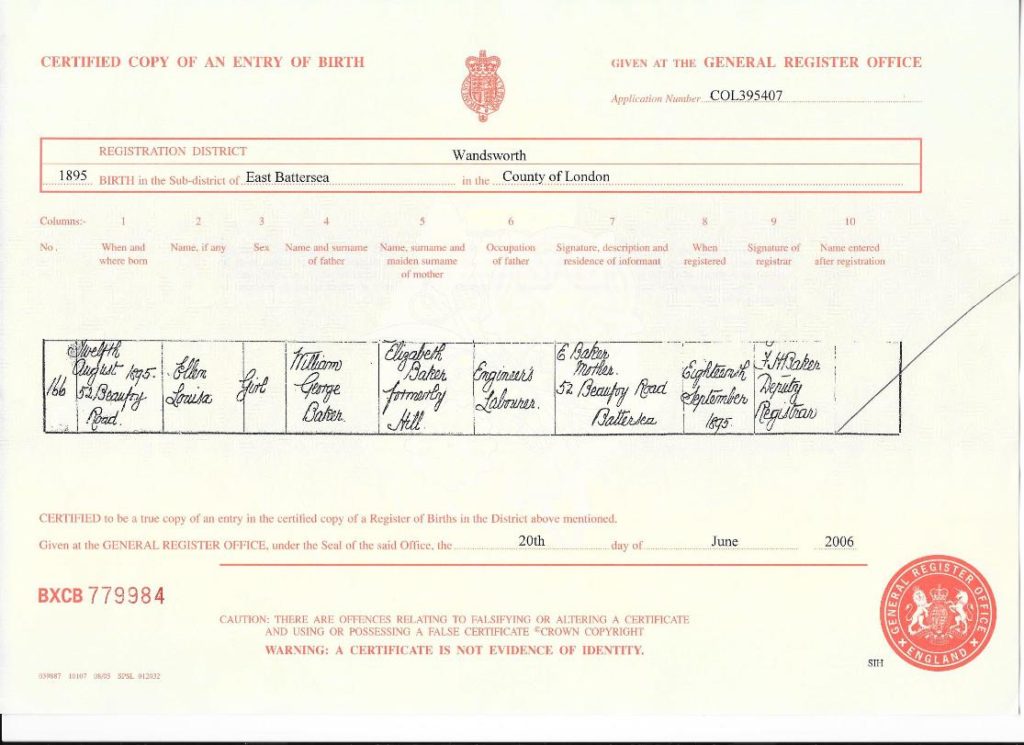
Was your ancestor overseas?
If you cannot find your ancestor in the GRO Index, it is possible he was in the Army and had been posted overseas.
Births, Marriages, and Deaths in the Armed Forces 1761-1995
These indexes include registrations relating to members of the British Armed Forces who were posted overseas. Regimental registers and chaplains’ returns also include information regarding army births that took place in the United Kingdom at barracks and garrisons.
The information included in the indexes incorporates:
- First Name
- Last Name
- Birth Date
- Birthplace
- Country
- Mother’s Maiden Name
- Volume Number
- Page Number
Army chaplains’ returns relate to births, marriages, and deaths taking place overseas. A date range of two to three years is given in the index, which also includes name and place.
Regimental Registers
Regimental Registers cover births and baptisms taking place between 1761 and 1924 for British Regiments stationed in the UK, Ireland and overseas.
These records include:
- GRO Regimental Birth Indices 1761 to 1924
- GRO Regimental Birth Indices Supplement 1761 to 1924
Chaplains’ Returns
Chaplains’ Returns cover births and baptisms, marriages and deaths from 1796 to 1880 and were compiled by forces chaplains.
Some entries may be duplicates of the information included in the Regimental Registers.
These records include:
- GRO Army Chaplains Birth Indices 1796 to 1880
- GRO Chaplains Returns Marriages 1796 to 1880
- GRO Army Chaplains Death Indices 1796 to 1880
Army Births, Marriages and Deaths 1881 to 1965
If your ancestor was born, married or died between 1881 and 1965, and was a member of the Armed Forces, it is prudent to check in the records below:
- GRO Army Birth Indices 1881 to 1965
- GRO Army Death Indices 1881 to 1955
- GRO Index Army Marriages 1881 to 1955
- GRO Army Marriages within British Lines 1914 to 1925
- GRO Service Department Marriages 1956 to 1965
- GRO Service Departments Death Indices 1956 to 1965
Other Army Registers
You can search the Army registers of baptisms, marriages, and burials in the UK and overseas garrisons (1808-2007) in the National Archives (WO 156). These registers mainly date from the 20th century.
Other indexes you can peruse in the National Archives include:
- RAF Chaplaincy Board registers of baptisms, confirmations, marriages, and burials 1919-2009 (AIR 82)
- Royal Navy Chaplaincy records of baptisms, marriages, and burials (1845-1998) (ADM 338)
Was Your Ancestor Born at Sea?
If you think your ancestor was born at sea, or died at sea, your best bet would be to search these GRO records:
- GRO Marine Death Indices
- GRO Marine Birth Indices 1837 to 1965
- GRO Marine Death Indices 1837 to 1846
- GRO Marine Death Indices 1846 to 1902
- GRO Marine Death Indices 1903 to 1965
These records mostly cover merchant seamen but some passengers may also be included in the indexes. The above records are all available on FindmyPast.
FindmyPast
FindmyPast is good for anyone, whether they are just starting their family history journey, or have already conducted some research.
It is especially good for people who wish to read newspaper articles.
Read my in-depth review to find out more about its features, advantages and disadvantages.
Where to Find the GRO Index
You are able to search the GRO Index in many Record Offices, large reference libraries, and some Family History Centres, where they are largely available on microfiche.
The GRO Index of births to 1934 and deaths to 1957 may be searched on the General Register Office’s website, but you have to register to use this index. Marriages are not, unfortunately, included in the GRO’s Online Index. It is now also possible to search births and deaths 1984-2020. Searching the index is free, but if you wish to order a certificate, a fee is payable.
The General Register Office’s index includes the mother’s maiden name in most entries in the birth index, where other indexes only include that information from September 1911. This makes it that much easier to track down any possible marriage and other children from the union.
It also includes age at death in most entries in the death index, where indexes in other places only include that information from March 1867.
To make use of this facility, you should follow these instructions:
Enter https://www.gro.gov.uk
Click Order Certificates Online
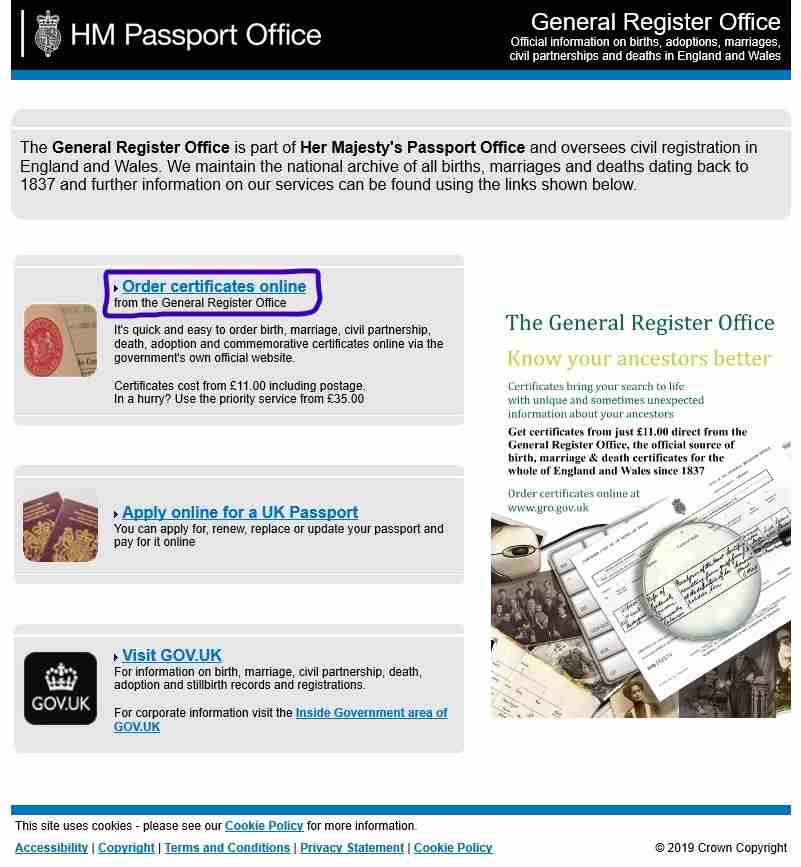
This will bring you to another screen where you should click Register as an Individual.
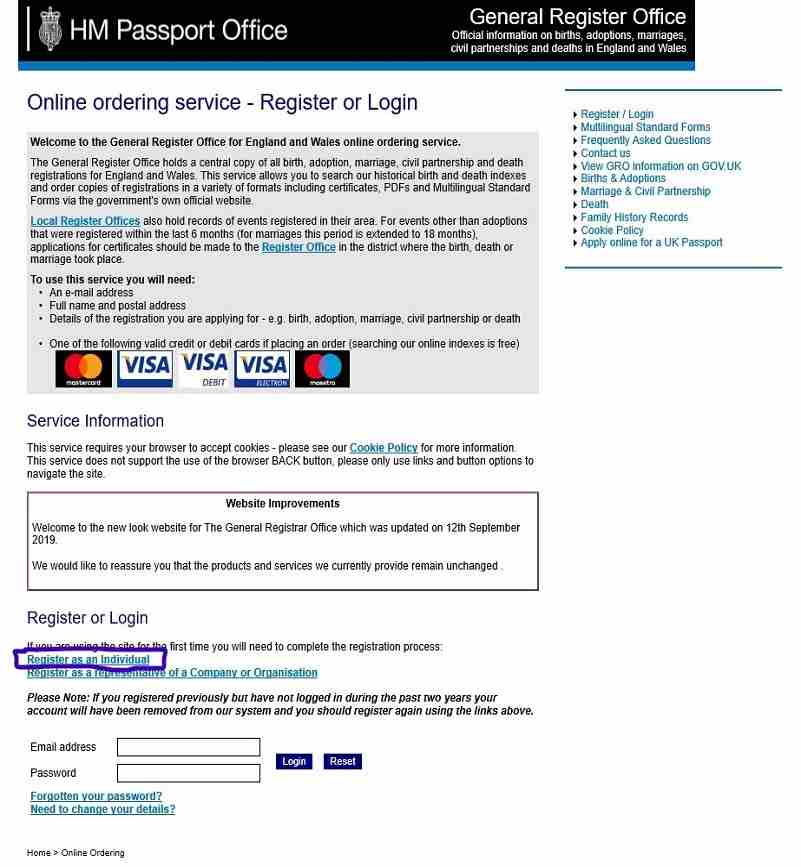
You should then enter your personal details such as email address, password, and name and address
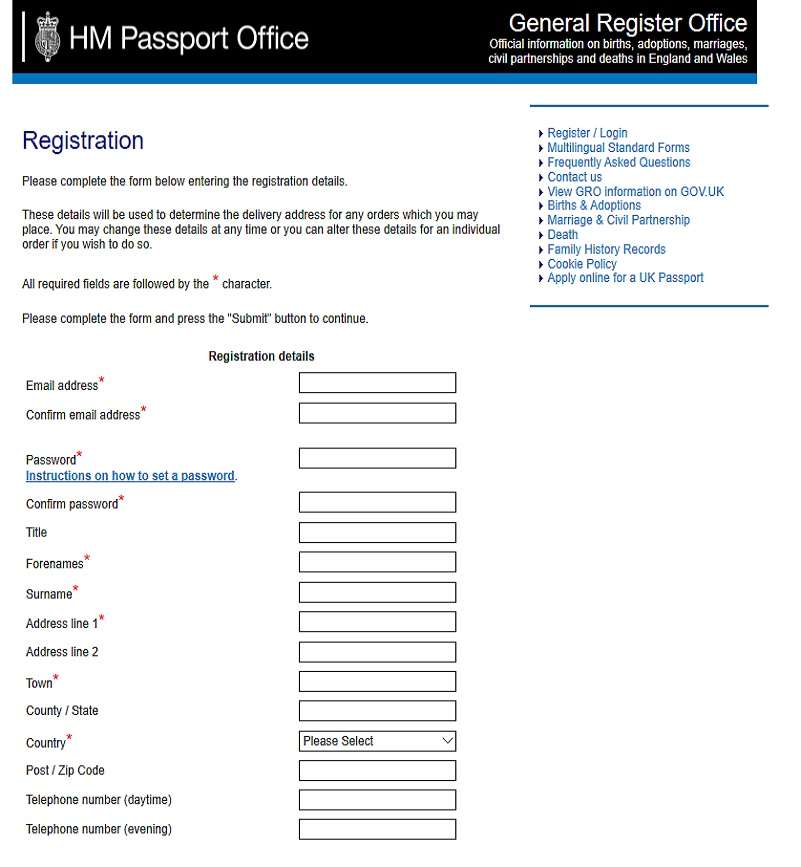
You then have to activate your account:
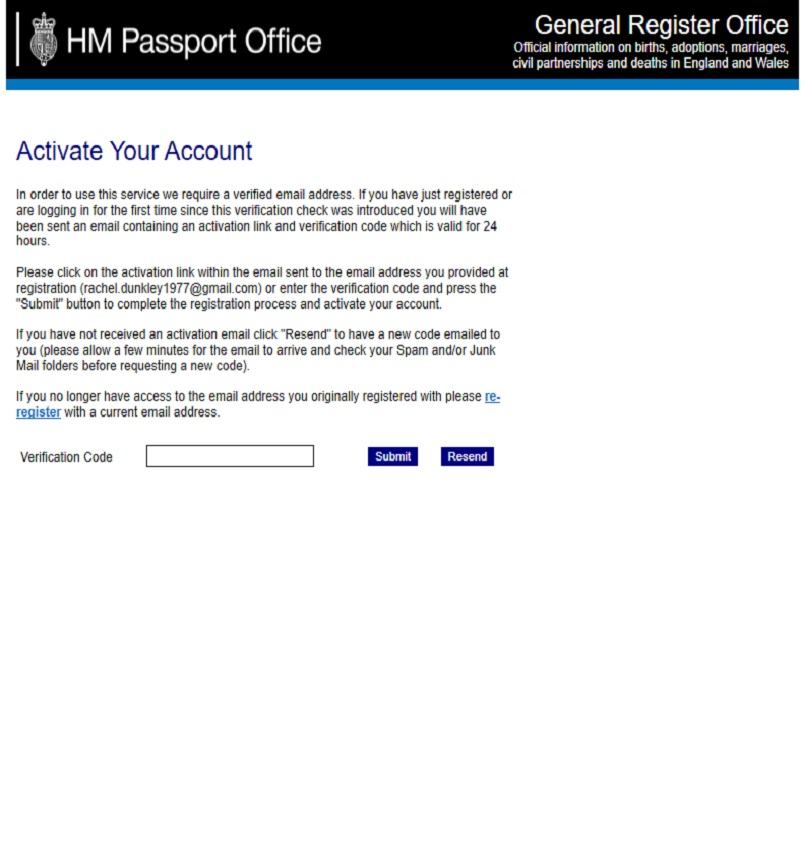
Once you have verified your account, you will be taken to the following screen where you should click search the GRO Indexes:
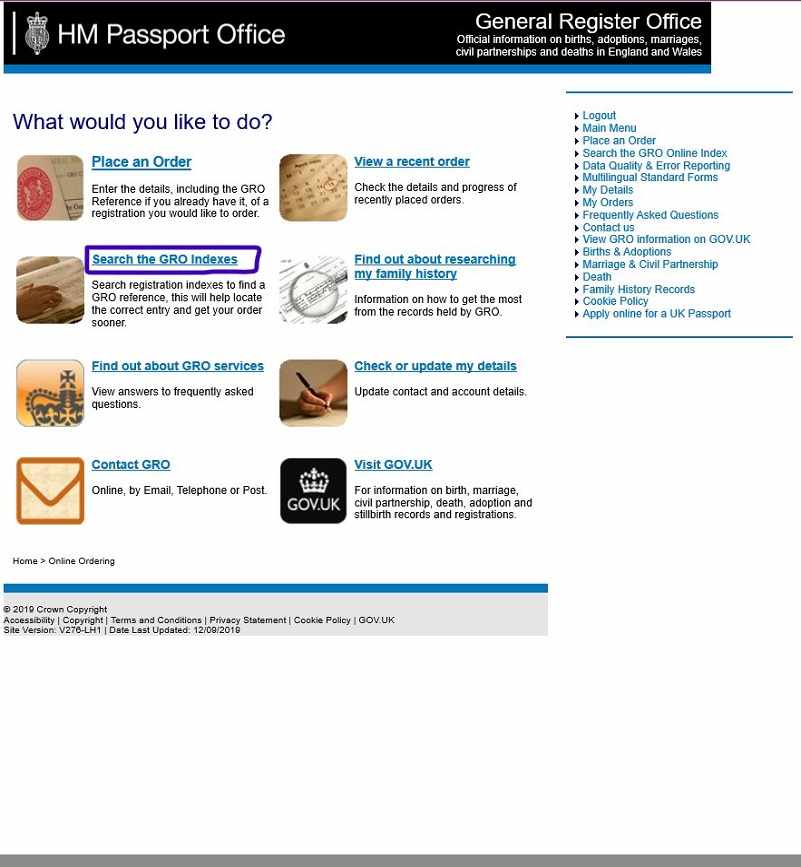
Click the button next to births or deaths
Enter your ancestor’s surname, gender, and birth year (you are able to search a two-year period such as 1848-1852 by inputting 1850 with a 2-year range).
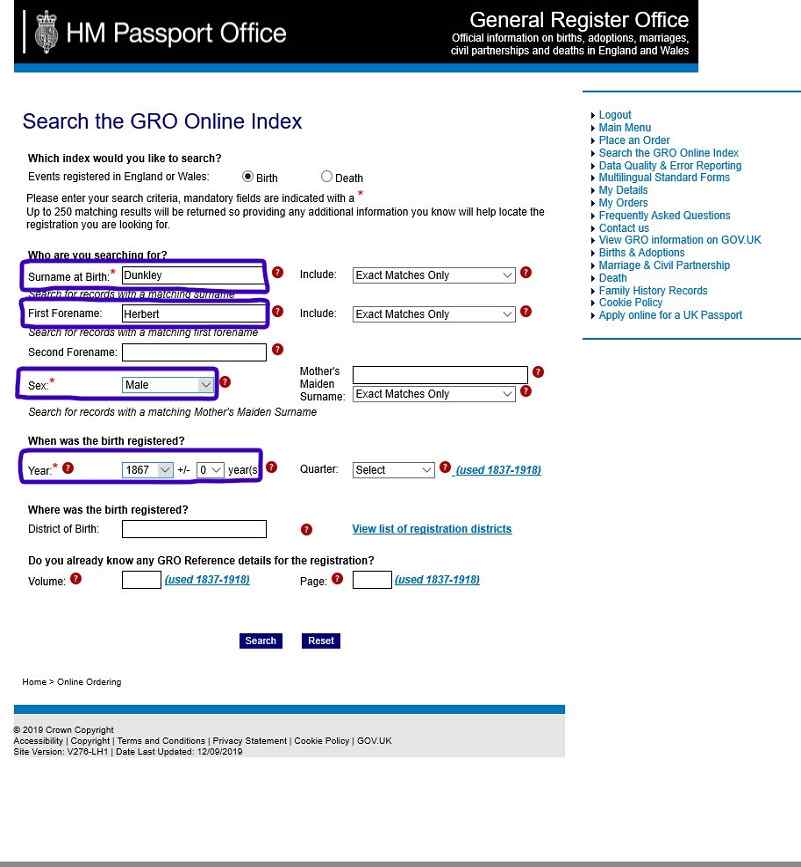
This should then show all the people fitting the search criteria.
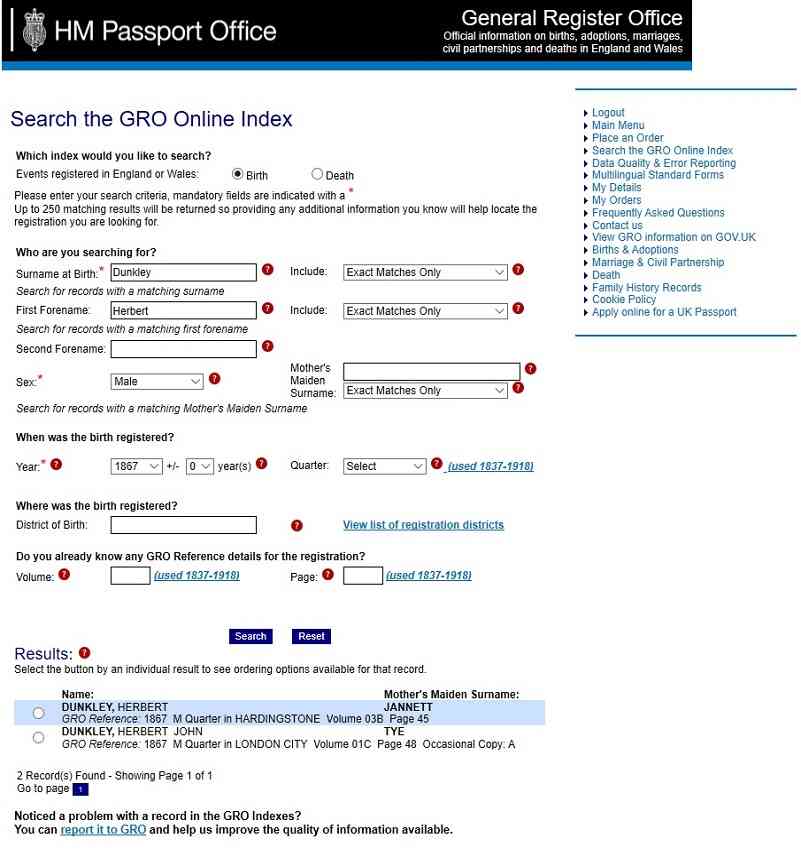
It can also be searched on-line at FreeBMD. The index is prepared by volunteers, being partially indexed to 1992 at present but more information is being added all the time. You are able to search through the images on the site, however. Go to FreeBMD’s homepage and click view images.
This will take you to a web-page where there is a sub-menu that allows you to search through birth, death, or marriage records, and then another menu on the following page will then take you to the pages where you may refine your search by years, quarters and finally the starting initial of their surname. This brings up a list of pages and you can then download or open the appropriate web page.
You can look at births, marriages, and deaths through Ancestry and FindmyPast.
Ancestry
Ancestry is great for anyone who does not have the time to, or is unable to, visit Record Offices or Libraries.
It is especially good if you wish to access records from the comfort of your home.
Read my in-depth review to find out more about its features, advantages, and disadvantages.
FindmyPast
FindmyPast is good for anyone, whether they are just starting their family history journey, or have already conducted some research.
It is especially good for people who wish to read newspaper articles.
Read my in-depth review to find out more about its features, advantages and disadvantages.
Once you have found the correct birth, marriage or death registration it is possible to order certificates online from the General Register Office.
The current price per certificate using the standard service is £12.50. You can obtain a PDF version of a birth certificate (1837-1918) or death certificate (1837-1957) for £8.00. For £3.00, it is now possible to obtain a digital image of any birth 1837-1922 or death 1837-1957, which you can download instantly.
Please view my guides to discover what information is contained on birth certificates, marriage certificates, or death certificates.
How to find a GRO Index Reference Number:
Birth Registrations
This is the format of an entry in the GRO Index up to July-September 1911 (known as the GRO Index reference number):
Mar 1867 Dunkley, Herbert Hardingstone 3b 45
March 1867 is the period in which the event was registered, Hardingstone the registration district, and 3b 45 the volume and page number and is used so the birth certificate can be located when ordered.
As the public was allowed six weeks to register a birth, you may discover a person born on 29th March 1850 was not registered until the quarter to June 1850.
If searching through the microfiche index, the mother’s maiden name is only included after September 1911, so this makes it more difficult to ascertain if you have found the appropriate entry before ordering the certificate. The GRO’s online index however includes the mother’s maiden name in most entries before 1911.
Marriage Registrations
This is an example of an entry in the GRO Index up to January-March 1912 (GRO Number):
Sep 1864 Dunkley, Isaac Hardingstone 3b 61
Sep 1864 Jannett, Jane Hardingstone 3b 61
As you can see from the above entry, Isaac Dunkley and Jane Jannett share the same information so that shows they could have married each other. There could be more than one wedding on each original page, however, so the two parties may not have married each other.
September 1864 is the period in which the marriage was registered, Hardingstone the registration district, and 3b 61 the volume and page number and is used in order that the marriage certificate can be located when ordered.
After the March quarter of 1912, the bride’s maiden name is included.
Death Registrations
This is an example of an entry in the GRO Index up to the January-March period of 1866 (GRO Number):
Jun 1862 McJanett Thomas Blaby 7a 27
June 1862 is the period in which the event was registered, Blaby the district, and 7a 27 the volume and page number. This information is used so the death certificate can be located when ordered.
If you are using the microfiche index, age at death is added from the March quarter of 1866 to June 1969, making it easier to locate the correct entry for your ancestor. The GRO’s online index, however, now includes age at death of people dying before 1866.
From the June quarter of 1969, the deceased’s birthdate is added, making it much easier to determine whether you have the correct registration before ordering the certificate and also makes it easier to find the appropriate birth registration when required.
